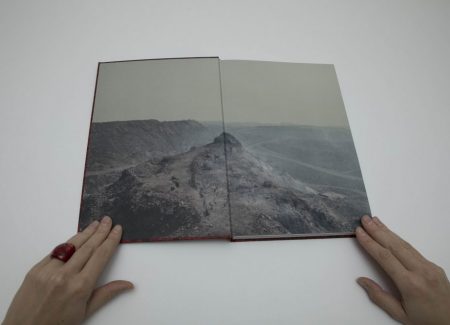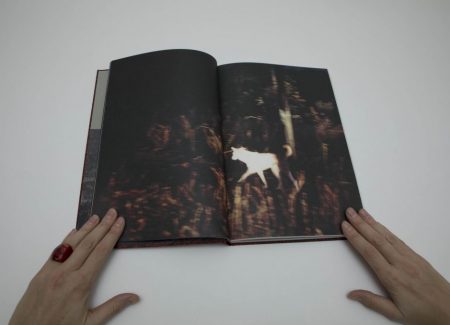JTF (just the facts): Published in November 2019 by Dewi Lewis Publishing (here). Hardcover, 192 pages, with 96 color photographs. Includes a small booklet and inserts, with an essay by Ivan Sigal; the text accompanying the photos of the women guerrillas was taken from the indigenous publication Women Martyrs of the Indian Revolution. Design by Teun van der Heijden. (Cover and spread shots below.)
Comments/Context: Poulomi Basu, a transmedia artist, photographer, and activist, was born and raised in India. Her work explores underreported contemporary subjects, often looking at overlooked connections between gender, identity, and geopolitics. One of her projects A Ritual of Exile (here) documents an extreme practice in remote Nepal where menstruating women and girls (seen as “impure” during this time) are banished from their homes and isolated. Women who bleed after childbirth are treated the same way. Alone in the wilderness, unprotected and isolated, many women die. Basu used a combination of photographs and an intimate VR film to tell the story.
Another of Basu’s long-term projects was just published as a photobook. Centralia looks at a little known and under-covered (in mainstream Western media) conflict, deep in the jungle of central India. It is a complex fight over natural resources, land, and identity. As the conflict deepens the indigenous population, the adivasis, have been caught between the Indian state and the Maoist guerrillas. Basu presents the project in the form of a hybrid of documentary and fiction, looking at “how our perceptions of reality and truth are manipulated.” Basu’s central interests are the women and their rights, and this time she turns her camera to the female Maoist guerrillas.
The title of the book, Centralia, has its origins in the United States, referring to a near-ghost town in Pennsylvania. Once a thriving mining center, today it is an abandoned place with melting asphalt and toxic gases due to a fire which has been burning under the town for over sixty years. The mining in Centralia has disappeared, and it is warning of what corporate mining and the associated violence is likely to bring to India.
Centralia has a striking cover, an abstract image of a face appears in black and red, with the title and artist’s name placed in the center. The cover has a rough texture, as if warning us about what is to follow. A photo of a gray desolate mining landscape is placed on the endpaper, pulling us right into the desperate reality. We then move through night shots of mining locations (some on fire) and the forest. Basu steps away from straightforward photojournalistic documentation, and the book avoids a linear narrative, instead creating a layered visual maze.
Over the decades, the indigenous people in this story were forced off their land, but they organized to fight back. Basu focuses on the role of ordinary women, in this case rural women who traditionally are not expected to have a voice. She thinks that the “female guerrillas are changing the face of the region and quietly challenging the prevailing orthodoxies of their societies.” Throughout the book, there are pixelated mugshots of dead militant female martyrs (these pages are printed on thinner paper), and the text placed along with these photographs reveals their stories. Basu shares the story of Ruppi, who “opposed forceful marriages, child marriages and oppressive traditions; she mobilised women into struggles.” She was 19 years old, and was kidnapped, raped and killed. Vijaya is another leader, who opposed her forced marriage and joined the squad. She learnt to read and write, and was killed at the age of 23.
Basu deliberately immerses us into a swirling visual narrative: there are local celebrations, crime scenes, the head of a baby goat, women in uniforms with old rifles, graves. A sequence of photographs depicting a group of villagers, young and old, and men in uniform, is printed on uncoated paper and cut horizontally, underlining the complexity of the situation and layering the connections between the various versions through the design elements.
Closer to the end, there is a verse from the Ramayana. “The Truth upholds the fragrant Earth and makes the living water wet. Truth makes fire burn and the air move, makes the sun shine and all life grow. A hidden truth supports everything. Find it and win.”
Centralia is not easy to digest; it calls for careful reading and engagement. I always wonder if books like this one, where a non-linear narrative is sprinkled with just a few hints, will have the power to draw in the audience and coherently make a connection. If you are willing to take on a challenge, Basu will take you “on a journey to a place where truth and lies, reality and fiction have become blurred.” Her photobook forces us to look at the horrifying realities of this ongoing war, and consider the gravity of these human rebellions with an increased sense of alarm.
Collector’s POV: Poulomi Basu does not appear to have consistent gallery representation at this time. As a result, interested collectors should likely follow up directly with the artist via her website (linked in the sidebar).

































